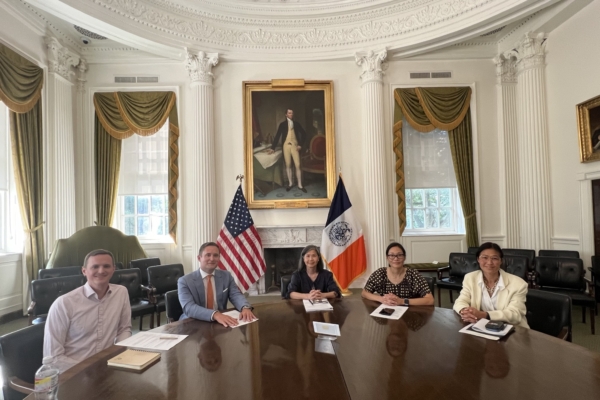The “Chinatown Connections” project has become the most eye-catching public construction project in Chinatown since Mayor Adams announced the plan in February. City officials held a media roundtable on August 27 to specifically explain the latest progress of the project.
New York City’s Chief Public Realm Officer, Liu Yating, along with Sun Huijun, Senior Vice President of New York City’s Economic Development Corporation (EDC), Vice President Chen Xiaoyan, Ed Pincar, who is in charge of Manhattan at the City’s Transportation Department, and EDC’s Vice President of Government and Community Relations, Li Jinzhi, attended the briefing.
According to the project details released by New York City in February this year, “Chinatown Connections” is a $56 million investment jointly made by the New York City government and the state of New York into Manhattan’s Chinatown. The funds will mainly be used to widen Liu Jin Plaza, construct a new arch, and beautify Bay Road. The project design work is expected to be completed by 2025, with construction starting in 2026.
Liu Yating stated that the construction design consultant team for the project has been selected, marking a significant milestone for such a major project.
In the United States, “construction design consultant” does not refer to a company but to a comprehensive team involved in the design of large-scale construction projects. Sun Huijun introduced that Marveldesigns has been chosen as the primary design company, with extensive experience in community public project design from their work on projects like Union Square and the waterfront public spaces.
Kathleen Chan, the project’s vice president, mentioned that the current team of construction design consultants involves around 17 sub-consultants (companies), including 30% minority and women-owned businesses. The revamp of Liu Jin Plaza involves engineers assessing the construction of both surface and underground facilities, including sewer infrastructure, electrical wiring, and public transportation facilities, which also involves utility companies such as the Department of Environmental Protection, Con Edison, and the MTA. The choices of location for the plaza and arch also depend on both above-ground and underground conditions.
Chen Zuozhou, the Executive Director of the Chinatown Business Improvement District, who has long been monitoring developments around Liu Jin Plaza, pointed out that the original design of the plaza was a makeshift solution. Positioned at the intersection of eight roads, vehicles converging at this juncture led to severe congestion, malfunctioning traffic signals, frequent accidents, and a lack of foot traffic due to safety concerns, resulting in many storefronts remaining vacant for years.
Vice President Chen Xiaoyan mentioned that the design of the plaza’s intersection is crucial, aiming to ensure safety for pedestrians, cyclists, and drivers while expanding the plaza space. The design team’s goal is to create a safe design plan that caters to the convenient passage of elderly and disabled community members, integrating bilingual signage, green spaces, and involving the Architectural Preservation Department in evaluating the design of statues and arches in the plaza.
The location for the arch is still undecided. Chen Xiaoyan revealed that the next step will involve bringing in an artist to join the consultant team, enhancing the integration of public art for the arch into the overall project design.
Moreover, efforts will be made to maintain the current position of the American Veterans Memorial Arch; while the statue of Lin Zexu will change position, creating more space in the plaza.
The issue of Bay Road’s closure once again became a focal point of concern for the Chinatown community, overseas organizations, and elected officials. Authorities have emphasized the importance of studying data on traffic flow, indicating a delay in the decision, now postponed until the end of the year.
As for the construction of features like bus islands on Bay Road, it is independently financed by the City’s Transportation Department as part of the Special Improvement Program (SIP), aiming to beautify Bay Road in various ways. This falls outside the scope of the “Chinatown Connections” project and follows its own schedule. Ed Pincar, the Manhattan official at the Transportation Department, stated that the project is planned to be completed within this year.

